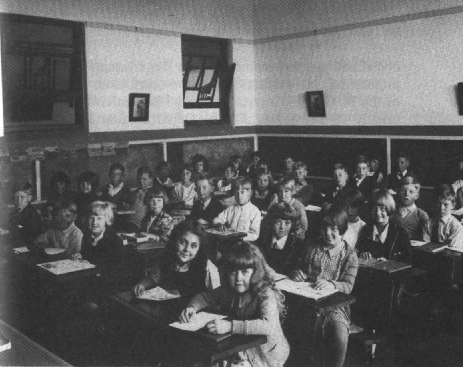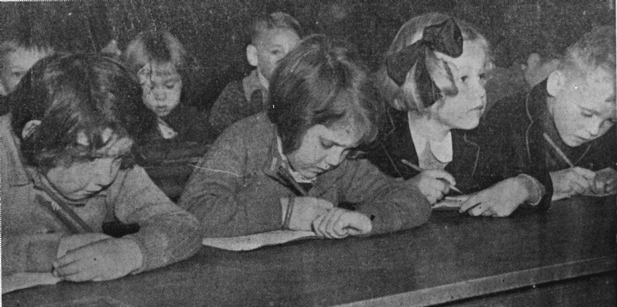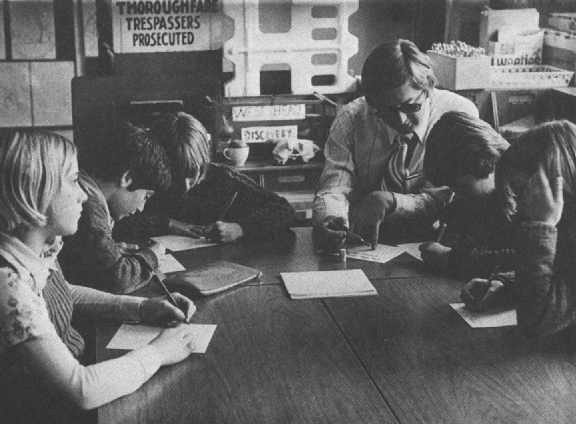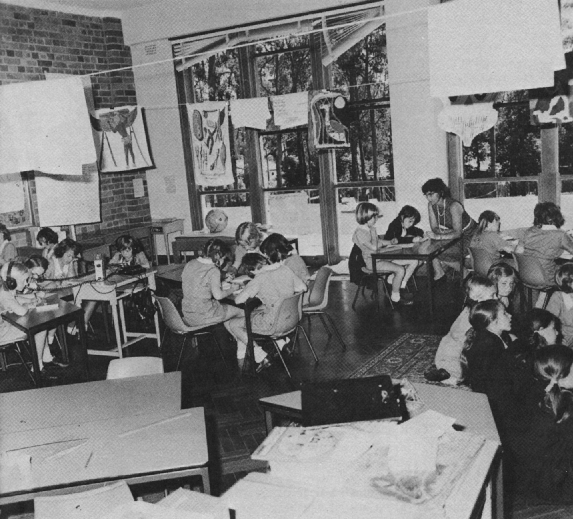 Sumerian classroom from c. 2,000 BCE.
Sumerian classroom from c. 2,000 BCE.Cross Cultural and Historical Perspectives on the Developmental Consequences of Education by Michael Cole in "Human Development" 2005
 “This fifteenth century classroom is believed
to be the one to which the young William Shakepeare
crept 'like a snail unwillingly to school'. Only recently
has a more flexibly organised room begun to emerge”.
“This fifteenth century classroom is believed
to be the one to which the young William Shakepeare
crept 'like a snail unwillingly to school'. Only recently
has a more flexibly organised room begun to emerge”. K-6 Best Years of Their Lives?, Primary English Teaching Association (of NSW), 1979.
 “I've had a look through our collection and there
seems to be a distinct lack of any internal photos of
the classrooms. ... I've attached a copy of the only classroom
shot we have and sadly this is from a very poor photographic
copy of the original. Chances are it's from the time of
J.T. Bell a headmaster (1918 - 1924) with an interest
in this new technology and taken by the local photographer
'Goodman'.
“I've had a look through our collection and there
seems to be a distinct lack of any internal photos of
the classrooms. ... I've attached a copy of the only classroom
shot we have and sadly this is from a very poor photographic
copy of the original. Chances are it's from the time of
J.T. Bell a headmaster (1918 - 1924) with an interest
in this new technology and taken by the local photographer
'Goodman'.“Let me know if it's of any interest. It's taken in the 'Big Room' which is still standing and strangely not too different from the version in the photo.
“Regards Lindsay Clapperton, Principal, Porepunkah Primary School, Porepunkah, Australia, 3740.”
 “A typical classroom of the 1930s, with its screwed
down desks and bare walls. Teaching and learning have
certainly changed! The picture dramatises the need for
continuing professional development and inservicing of
teachers. [Photo courtesy of NSW Governmment Printing
Office]” — Making Good Schools Better,
Melbourne 1988.
“A typical classroom of the 1930s, with its screwed
down desks and bare walls. Teaching and learning have
certainly changed! The picture dramatises the need for
continuing professional development and inservicing of
teachers. [Photo courtesy of NSW Governmment Printing
Office]” — Making Good Schools Better,
Melbourne 1988.Note that the sexes are strictly segregated. In my own school, segregation was much more marked even in the 1950s, with boys on one side, girls on the other side of the room. Friends were usually allowed to sit together, but "trouble-makers" were often sat in the front. Some teachers used test-results to determine seating position.
 “School's in at Ascot, and little pupils, all left
arms 'covering' their work, all pencils pointed over the
right shoulder and heads bent studiously, set about making
neat rows of pot-hooks” (1940s)
“School's in at Ascot, and little pupils, all left
arms 'covering' their work, all pencils pointed over the
right shoulder and heads bent studiously, set about making
neat rows of pot-hooks” (1940s)—Official History of Ascot School, Queensland.
 This photograph of about 1950 (Springwood Public School)
shows not an extreme but rather a typical 'yesterday'
classroom. The desks are arranged to centre attention
on the teacher; they probably stayed in this position
all the year; there is little scope for any activity other
than sitting; and no use is made of the walls. It can
be compared with photos of the 1970s classrooms on
other pages”
This photograph of about 1950 (Springwood Public School)
shows not an extreme but rather a typical 'yesterday'
classroom. The desks are arranged to centre attention
on the teacher; they probably stayed in this position
all the year; there is little scope for any activity other
than sitting; and no use is made of the walls. It can
be compared with photos of the 1970s classrooms on
other pages”—K-6 Best Years of Their Lives?, Primary English Teaching Association (of NSW), 1979.
Note that the principle of sitting boys with boys and girls with girls has started to be eroded in this school. Quite unusual for the 1950s. But the 'tablecloths' on each desk betray that this is a relatively well-off school.
 “'First-hand observation, manipulation and investigation
provide opportunities for inquiry, discovery and use of initiative.
- Aims of Primary Education”
“'First-hand observation, manipulation and investigation
provide opportunities for inquiry, discovery and use of initiative.
- Aims of Primary Education”— K-6 Best Years of Their Lives?, Primary English Teaching Association (of NSW), 1979.
 “This teacher has arranged his classroom so that he
can work with a small group while the rest of the class, in
other groups, go about a variety of projects.
“This teacher has arranged his classroom so that he
can work with a small group while the rest of the class, in
other groups, go about a variety of projects.— K-6 Best Years of Their Lives?, Primary English Teaching Association (of NSW), 1979.
 “The modern 'open space' classroom represents a huge
change of environment after centuries of 'screwed down desks
in serried rows'.”
“The modern 'open space' classroom represents a huge
change of environment after centuries of 'screwed down desks
in serried rows'.”— K-6 etc., 1979